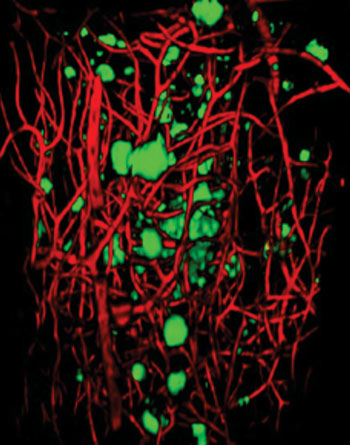New Optical Clearing Method Preserves Critical Brain Tissue Structures
By LabMedica International staff writers
Posted on 01 Oct 2015
A recent paper described the use of a sorbitol-based optical clearing method that provides stable tissue preservation for immunochemical labeling and three-dimensional signal rendering.Posted on 01 Oct 2015
Existing tissue clearing reagents contain chemical components that can compromise tissue structure, preventing reproducible anatomical and fluorescence signal stability.

Image: A three-dimensional visualization of A-beta plaques (green) and blood vessels (red) in a region of cerebral cortex from a 20-month-old Alzheimer\'s disease model mouse (Photo courtesy of RIKEN Brain Science Institute).
To avoid tissue damage from the clearing reagent, investigators at the RIKEN Brain Science Institute (Saitama, Japan) spent the last five years improving their urea-based Scale clearing reagent. The result, the sorbitol-based ScaleS reagent, was used to prepare tissues from the brains of mice with a genetic model of Alzheimer's disease.
Results published in the September 14, 2015, online edition of the journal Nature Neuroscience revealed that comparative benchmarking of contemporary clearing agents showed that ScaleS provided superior signal and structural preservation. ScaleS permitted optical reconstructions of aged and diseased brain in Alzheimer's disease models, including mapping of three-dimensional networks of amyloid plaques, neurons, and microglia, and multiscale tracking of single plaques by successive fluorescence and electron microscopy.
"The key ingredient of our new formula is sorbitol, a common sugar alcohol," said senior author Dr. Atsushi Miyawaki, senior team leader in cell function dynamics at the RIKEN Brain Science Institute. "By combining sorbitol in the right proportion with urea, we could create transparent brains with minimal tissue damage, that can handle both fluorescent and immunohistochemical labeling techniques, and is even effective in older animals."
"Clearing tissue with ScaleS followed by three-dimensional microscopy has clear advantages over two-dimensional stereology or immunohistochemistry," said Dr. Miyawaki. "Our technique will be useful not only for visualizing plaques in Alzheimer's disease, but also for examining normal neural circuits and pinpointing structural changes that characterize other brain diseases."
Related Links:
RIKEN Brain Science Institute










 (3) (1).png)


